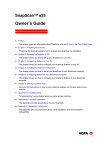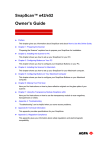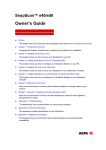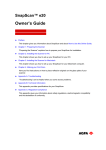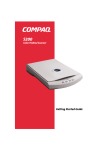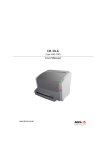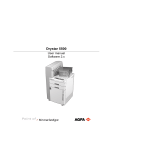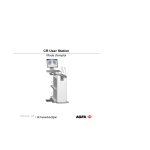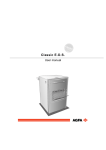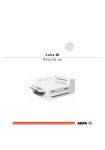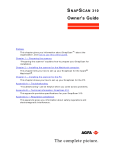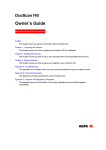Download AGFA SNAPSCAN E10 Technical information
Transcript
SnapScan e10 Owner’s Guide ! Preface This chapter gives you information about SnapScan and about How to Use This Online Guide. ! Chapter 1: Preparing the Scanner “Preparing the Scanner” explains how to prepare your SnapScan for installation. ! Chapter 2: Installing the Scanner for PC This chapter shows you how to set up your SnapScan for your PC. ! Chapter 3: Installing the Scanner for Macintosh This chapter shows you how to set up your SnapScan for your Macintosh computer. ! Chapter 4: Making Your First Scan Here you find instructions on how to place reflective originals on the glass plate of your scanner. ! Appendix A: Troubleshooting “Troubleshooting” can be helpful when you come across problems. ! Appendix B: Technical Information This appendix provides specifications for your SnapScan. ! Appendix C: Regulation Compliance This appendix gives you information about safety regulations, electromagnetic compatibility and the declaration of conformity. ab Trademarks AGFA and the Agfa rhombus are trademarks of Agfa-Gevaert AG ScanWise and SnapScan e10 are trademarks of Agfa-Gevaert N.V. Acrobat is a trademark of Adobe Systems Incorporated which may be registered in certain jurisdictions. Apple, Macintosh, PowerPC and Mac OS are trademarks of Apple Computer Inc., registered in the U.S. and other countries. IBM PC is a trademark of the International Business Machines Corporation. Microsoft, Windows and Windows NT are registered trademarks of the Microsoft Corporation in the U.S. and other countries. Pentium is a registered trademark of the Intel Corporation. Other product or company names are trademarks or registered trademarks of their respective holders. Copyright© July 2000 Agfa-Gevaert N.V. All rights reserved. All software and hardware described in this document are subject to change without any notice. Trademarks 2 Contents Preface ............................................................................................................................................... 4 About SnapScan ......................................................................................................................... 5 Environmental Requirements...................................................................................................... 5 Precautions ................................................................................................................................. 6 Cleaning Your Scanner ............................................................................................................... 6 How to Use This Online Guide.................................................................................................... 7 How to Print This Guide .............................................................................................................. 7 Chapter 1: Preparing the Scanner................................................................................................... 8 Unpacking the Scanner............................................................................................................... 9 Taking a Closer Look .................................................................................................................. 9 Unlocking the Scanner .............................................................................................................. 10 Chapter 2: Installing the Scanner for PC...................................................................................... 12 Minimum System Requirements ............................................................................................... 13 Installing the Scanner Software................................................................................................. 13 Connecting the Scanner to Your PC ......................................................................................... 15 Chapter 3: Installing the Scanner for Macintosh......................................................................... 16 Minimum System Requirements ............................................................................................... 17 Installing the Scanner Software................................................................................................. 18 Connecting the Scanner to the Macintosh Computer ............................................................... 20 Chapter 4: Making Your First Scan ............................................................................................... 21 Appendix A: Troubleshooting ....................................................................................................... 23 Appendix B: Technical Information .............................................................................................. 26 Appendix C: Regulation Compliance............................................................................................ 27 Safety Regulations .................................................................................................................... 28 UL Safety Statement.................................................................................................. 28 TÜV: Wichtige Sicherheitshinweise........................................................................... 28 Electromagnetic Compatibility................................................................................................... 29 Federal Communications Commission Radio Frequency Interference Statement.... 29 Industry Canada Class A and B Label Requirements ............................................... 29 Declaration of Conformity: SnapScan e10 ................................................................................ 30 Preface 3 Preface ! About SnapScan ! Environmental Requirements ! Precautions ! Cleaning Your Scanner ! How to Use This Online Guide ! How to Print This Guide Preface 4 About SnapScan In this Owner’s Guide, the name SnapScan is used for the SnapScan e10 (unless specified otherwise). The SnapScan is a one pass flatbed color scanner with a resolution of 600 x 1200 ppi equipped with a cold cathode lamp. It is based on CCD (Charge-Coupled Device) scanning technology. With the SnapScan, you can scan line-art, gray-scale and color reflective originals up to A4 format. The scanned data is transferred through the computer’s USB (Universal Serial Bus) port. The USB technology makes it easy to install multiple peripherals to your computer. USB eliminates any need to turn off or restart the computer when attaching a new peripheral. SnapScan is a scanner that captures and converts reflective originals (for example pictures, text) into electronic data that can be used in computer applications. It offers high-resolution image capturing and is an ideal tool in making presentations come to life. SnapScan supports multiple scanning modes and includes scanner software to get you started right away. With its powerful and easy-to-use scanner driver software, SnapScan gives you easy access to high-quality color scans. The scanner driver software gives you a number of additional features to create special effects or to reproduce even the most difficult originals. The document cover is adjustable: when you put a thick original (like a book or a magazine) on the reflective glass plate, the document cover adapts to the thickness of the original. Environmental Requirements " Place the scanner on a horizontal, flat surface. " To ensure proper ventilation, allow a minimum of 10 cm (4 inches) free space around each side of the scanner. " Make sure that no vibrations or shocks occur. " Make sure that the area is free of dust. " Avoid any contact with water. Do not use your scanner near water or in a damp environment. " Your SnapScan is designed to perform at best when the environmental humidity is between 20% and 85%. Avoid environments where humidity fluctuations might occur. " Your SnapScan is designed to perform at best when the environmental temperature is between 10 °C (+ 50 degrees Fahrenheit) and 40 °C (+104 degrees Fahrenheit). Avoid exposure to direct sunlight and heating devices. Preface 5 Precautions For your own safety and that of your equipment, respect conscientiously the Environmental Requirements and always take the following precautions: " Check frequently whether there is no overheating of the AC adapter. " If you do not use your scanner for some time, pull the AC adapter cable out of the power supply socket. " Handle your SnapScan with care: the glass plate is fragile. There is no warranty on breaking the glass plate and your dealer is not liable for consequential damages. " Disconnect the AC adapter when you want to clean the scanner housing or the glass plate and when the scanner needs servicing or repairing. " Do not open the scanner housing as it contains high-voltage areas and sensitive components. Every repair should be carried out by your dealer. " Do not leave originals on the reflective glass plate for excessive periods of time. The warmth of the scanner may cause them to deteriorate. " For safety reasons, never use extension cables for the AC adapter. Caution: For safety reasons, besides the personal maintenance mentioned in this Owner's Guide, do not try to remove any mechanical parts or any electronic components from your scanner. If your scanner needs service, our dealer and service offices are available to help you. Cleaning Your Scanner " Cleaning the glass plate regularly, ensures that dirt or smudges do not reduce the quality of your scanned images. " Before cleaning, disconnect the AC adapter from your scanner. " Use a soft damp cloth and a mild detergent to clean the surface of the glass plate. If you use alcohol to clean the glass plate, make sure that you do not touch the plastic elements of the scanner. " Avoid using sprays directly onto the glass plate as this may cause the liquid to penetrate the seams around the glass and contaminate the mirrors and lenses inside the scanner. " Do not use liquid cleaners or aerosol cleaners. Preface 6 How to Use This Online Guide To … Click … jump to another location within or outside the document blue text jump to a topic in the document click the corresponding bookmark jump to the first or the last page retrace your steps in the document jump to the previous or to the next page zoom in and zoom out (control-click) on the page search for a part of a word, a complete word or multiple words print the document # Note: Due to rescaling, some of the screen shots included in this document may appear unclear when displayed at 100% magnification. You can view these screen shots more clearly by using the Zoom tool to increase the default magnification. How to Print This Guide 1 Choose Page Setup from the File menu. 2 Choose your paper format from the Paper popup menu. 3 Select Orientation: Portrait. 4 Click OK. 5 Choose Print from the File menu. Preface 7 Chapter 1: Preparing the Scanner This chapter helps you to prepare your SnapScan for installation. ! Unpacking the Scanner ! Taking a Closer Look ! Unlocking the Scanner Chapter 1: Preparing the Scanner 8 Unpacking the Scanner 1 Open the packing box and carefully unpack all the items. 2 Check each item to make sure that everything listed on the Packing List (printed on the box) is present. Check if there is no visible defect. If something is missing, contact your dealer. 3 Remove the plastic wrapping and the packing materials from the scanner. ! Note: Do not throw away the packing materials. They can be useful to protect the scanner during later transport. Taking a Closer Look When you have taken the scanner out of the box, take a closer look at its parts. The following figures illustrate the different parts of your SnapScan. 1. adjustable document cover 2. glass plate 3. status indicator Chapter 1: Preparing the Scanner 9 The following figure illustrates the location of the different parts at the rear of your scanner. 1. Power connector 2. USB Port (labeled with the USB icon ) to make a connection to your computer Unlocking the Scanner Before you start using the scanner, you first have to unlock it. 1 Place the scanner on a horizontal, flat surface and pull it carefully towards you until you can see the locking screw at the bottom. Chapter 1: Preparing the Scanner 10 2 Rotate the locking screw in the direction of . Your scanner is unlocked. # Note: If you want to transport your scanner, you have to lock it. To do this, first connect the AC adapter to the scanner so that its optical assembly moves to its home position. Then, rotate the locking screw in the direction of and disconnect the scanner. Your scanner is now locked and ready for transportation. Caution: Make sure to install the ScanWise software before connecting the scanner to your PC or Macintosh computer. Chapter 1: Preparing the Scanner 11 Chapter 2: Installing the Scanner for PC This chapter shows you how to set up your SnapScan for your PC. ! Minimum System Requirements ! Installing the Scanner Software ! Connecting the Scanner to Your PC Chapter 2: Installing the Scanner for PC 12 Minimum System Requirements " A USB port " A Pentium® processor " A 14 inch color monitor " A video card that can display a minimum of 16 bit high color " 32 MB of RAM (64 MB of RAM is recommended) " A CD-ROM drive " Windows® 98 " ScanWise is compatible with all IBM™ PCs and compatibles running Windows 98/2000 " The amount of disk space available on your PC determines the number and the size of the images that you can scan. Make sure that you have enough free storage space on your hard disk. You need about two times the size of the image to scan, edit and save it. Installing the Scanner Software 1 Insert the Agfa ScanWise CD-ROM in your CD-ROM drive. # 2 Note: If the ScanWise Installer program does not appear automatically, carry out the following instructions: 1 Double-click My computer. 2 Double-click the CD-ROM drive. 3 Double-click Setup.exe. Click the up or down arrow to select your language. This selection determines the language of the ScanWise software and documentation. 3 Click the up or down arrow to select your type of scanner (if needed). 4 Click the dotted right arrow or move the slider to about ScanWise. A demonstration of ScanWise will start. 5 Click the dotted right arrow or move the slider to Install. 6 Click Acrobat Reader to start the installation. You need Acrobat Reader to read the documentation. Chapter 2: Installing the Scanner for PC 13 7 Follow the instructions on your screen. When the installation is finished, the Install screen appears again. 8 Click ScanWise to start the Installation. 9 Follow the instructions on your screen. # Note: During installation the Register ScanWise window appears. You can choose to register now or later. $ Register now: If you choose to register now, the Agfa webpage opens. Here you can register online. $ Register later: If you choose to register later, you can register afterwards via Start/Programs/Agfa ScanWise/Register ScanWise. By registering online, you will create your personal e-Service account and you will enjoy the following benefits: 1. Customized self-help tools: You have access to the following self-help tools that are customized according to your eservice account profile: 2. 1. Software downloads 2. Technical knowledge database (FAQ) 3. Online manuals and documentation 4. Access to third-party software support sites Personalized one-to-one technical support: Agfa assists you online if you have additional questions about technical issues. 3. Automatic e-mail notification: Agfa notifies you immediately when new software and upgrades are available for downloading. # Note: For support issues, go to http://support.agfa.com. # Note: For the latest information, consult the ScanWise Read Me File. When installation is finished you are ready to connect your scanner to your PC. Chapter 2: Installing the Scanner for PC 14 Connecting the Scanner to Your PC Caution: For your safety, use the adapter that comes with this product. Do not use any substitute. Misuse of the power adapter can cause serious damage to the product and a safety hazard while using it. # Note: Check if the AC Adapter complies with your local power supply. # Note: Make sure the scanner is unlocked (see Unlocking the Scanner) before connecting it to the electric outlet. 1 Connect the plug of the AC adapter to your scanner. 2 Connect one end of your USB cable to the USB port on your scanner. Make sure you connect the correct plug as shown in the figure above. 3 Plug the adapter in the wall outlet. 4 Connect the other end of your USB cable to a USB port on your computer. Make sure you connect it to the correct port as shown in the figure below. A USB port is labeled with the USB icon . Windows 98/2000 will now detect the scanner and will install the necessary files for the scanner hardware driver. Chapter 2: Installing the Scanner for PC 15 Chapter 3: Installing the Scanner for Macintosh This chapter shows you how to set up your SnapScan for your Macintosh. ! Minimum System Requirements ! Installing the Scanner Software ! Connecting the Scanner to the Macintosh Computer Chapter 3: Installing the Scanner for Macintosh 16 Minimum System Requirements ! A USB port ! A PowerPC® processor ! A 14 inch color monitor with thousands of colors for an accurate display of color images ! 32 MB of RAM ! A CD-ROM drive ! Mac® OS 8 or higher Chapter 3: Installing the Scanner for Macintosh 17 Installing the Scanner Software Caution: To scan from within your image editing software, make sure to install the image editing software before installing ScanWise. 1 Insert the Agfa ScanWise CD-ROM in the CD-ROM drive. " Note: If the ScanWise window does not open automatically, double-click the CD-ROM icon on your desktop. The Agfa ScanWise window opens. 2 Double-click the ScanWise Installer icon. 3 Click the up or down arrow to select your language. This selection determines the language of the ScanWise software and documentation. 4 Click the up or down arrow to select your type of scanner (if needed). 5 Click the dotted right arrow or move the slider to about ScanWise. A demonstration of ScanWise will start. 6 Click the dotted right arrow or move the slider to Install. 7 Click Acrobat Reader to start the installation. You need Acrobat Reader to read the documentation. 8 Follow the instructions on your screen. When the installation is finished, the Install screen appears again. 9 Click ScanWise to start the Installation. 10 Follow the instructions on your screen. " Note: After installation the Register ScanWise window appears. # Register now: If you choose to register now, the Agfa webpage opens. Here you can register online. # Register later: If you choose to register later, you can register afterwards by doubleclicking the ‘Product Registration’ icon in the ScanWise folder. Chapter 3: Installing the Scanner for Macintosh 18 By registering online, you will create your personal e-Service account and you will enjoy the following benefits: 1. Customized self-help tools: You have access to the following self-help tools which are customized according to your eservice account profile: 1. Software downloads 2. Technical knowledge database (FAQ) 3. Online manuals and documentation 4. Access to third-party software support sites Personalized one-to-one technical support: Agfa assists you online if you have additional questions about technical issues. Automatic e-mail notification: Agfa notifies you immediately when new software and upgrades are available for downloading. " Note: For support issues, go to http://support.agfa.com. When the installation is finished you are ready to connect your scanner to your Macintosh computer. Caution: Before using ScanWise on a system with 32 MB physical RAM, it is advised to increase the virtual memory to 64 MB: 1 Choose Control Panels > Memory from the Apple menu ( ). The Memory window appears. 2 Increase the virtual memory to 64 MB. 3 Restart your Macintosh. Chapter 3: Installing the Scanner for Macintosh 19 Connecting the Scanner to the Macintosh Computer Caution: For your safety, use the adapter that comes with this product. Do not use any substitute. Misuse of the power adapter can cause serious damage to the product and a safety hazard while using it. # Note: Check if the AC Adapter complies with your local power supply. # Note: Make sure the scanner is unlocked (see Unlocking the Scanner) before connecting it to the electric outlet. 1 Connect the plug of the AC adapter to your scanner. 2 Connect one end of your USB cable to the USB port on your scanner. Make sure you connect the correct plug as shown in the figure above. 3 Plug the adapter in the wall outlet. 4 Connect the other end of your USB cable to a USB port on your computer. Make sure you connect it to the correct port as shown in the figure below. A USB port is labeled with the USB icon . Chapter 3: Installing the Scanner for Macintosh 20 Chapter 4: Making Your First Scan 1 Place a color photograph face down on the glass plate with the top side against the middle of the front ruler. 2 The optical performance of a CCD scanner is always best near the middle of the glass plate. However, the specified scan quality is guaranteed for the entire scan area. If you put more than one original on the glass plate, position them as close to the center line as possible to optimize the quality. 3 Close the document cover of the scanner. ! 4 Note: The adjustable document cover makes it possible to scan from books and magazines. When you put a thick original on the reflective glass plate, the document cover adapts to the thickness of the original. For PC: In the Start menu, select Programs, Agfa ScanWise to open the ScanWise application. -orFor Macintosh: Go to the Agfa ScanWise folder on your hard disk and double-click Chapter 4: Making Your First Scan . 21 5 Select your scanner (if needed). # Note: This dialog only appears the first time you use ScanWise. 6 Click Yes when the system asks to guide you. 7 Follow the steps described in the ScanWise Guide Me mode. For more information consult the ScanWise Application Guide and the Agfa Contacts on your Agfa ScanWise CD-ROM. After installation you can access these documents via the Start menu on your PC or via the ScanWise icon on the desktop of your Macintosh. # Note: If you encounter problems, please consult the ScanWise Read Me file on your computer or Appendix A: Troubleshooting in this Owner’s Guide. Chapter 4: Making Your First Scan 22 Appendix A: Troubleshooting This section gives solutions for some common problems you may come across when starting up or using your SnapScan. There is no USB port free for your scanner. " Check if you can use a USB port on the keyboard or monitor. " Use a USB hub. The status indicator fails to light up. " Verify the power connection to the scanner. " If the power connection is working, contact your dealer or local Agfa support center. The scanner makes an unusual noise and the scanner lamp does not move back and forth when you connect the scanner. " The scanner was not properly unlocked. Immediately disconnect the AC adapter and unlock the scanner properly, or contact your dealer or local Agfa support center. The scanner lamp flickers, dims, or fails to light up. " The cold cathode lamp of your scanner needs to be replaced. Contact your dealer or local Agfa support center. ScanWise cannot find the scanner (MACINTOSH ONLY). If the scanner driver cannot find the scanner, a message appears telling you that no scanner is connected. " Check if the scanner is connected with the USB cable to your computer and that the AC adapter is plugged in. It can always happen that a USB port is damaged, therefore try the other USB port of your computer. " Open the Apple System Profiler that you find under the menu. Click the tab ‘Devices and Volumes’ (minimum version 8.5). Here you can check if the USB device is found. If USB is not present in the list of ‘Devices and Volumes’, please check the hardware (cable, USB ports, ...). " Disconnect the AC adapter and reconnect it again. # Note: If you encounter other problems during or after installation, please consult the ScanWise Read Me file on your computer. The driver is not found when you connect the scanner to your computer (MACINTOSH ONLY). If ScanWise is not installed correctly, the following message appears: “The software needed to use the device SnapScan e10 cannot be found”. " Re-install ScanWise. " Check if the Extensions folder contains the file ‘Agfa USB e10’. This driver is necessary for detecting the scanner. Appendix A: Troubleshooting 23 You cannot scan from within your image editing software (MACINTOSH ONLY). If ScanWise is installed before the image editing software, no plug-ins will be available in the image editing software. " Uninstall and re-install ScanWise. Windows 98 fails to detect the scanner when you connect it for the first time (PC ONLY). " Check if the scanner is connected with the USB cable to your computer and that the AC adapter is plugged in. It can always happen that a USB port is damaged, therefore try the other USB port of your computer. " Check if the Device Manager finds the USB controller. To check if the USB controller is present in the Device Manager, click with the right mouse button on the icon My Computer and select Properties from the menu that pops up. Select the Device Manager tab from the System Properties dialog box. $ If the USB controller ( ) is present in the Device Manager, carry out the scanner installation procedure exactly as described in this manual. $ If the USB controller is not present in the Device Manager, carry out the following instructions: 1 Restart your computer. 2 Enable the USB controller in the BIOS settings. Caution: Changing your computer’s BIOS settings is at your own risk! It should be done by system administrators and experienced users only. If you are not familiar with these tasks, ask your computer dealer to do this for you. You typically do this by pressing a key combination during the startup of your PC. Consult your computer manual for more information. 3 Exit and save the changes you made. Your computer is rebooted automatically. " Check again if the Universal serial bus controller is present in the Device Manager. $ If the Universal serial bus controller ( ) is present in the Device Manager, carry out the scanner installation procedure exactly as described in this manual. $ If the Universal serial bus controller is still not present in the Device Manager, carry out the following instructions: 1 Click the Start button. 2 Select Settings. 3 Select Control Panel. 4 Double-click on the Add New Hardware icon. 5 Attentively follow the instructions that appear on your screen. The Universal Serial Bus controller should now be present in the Device Manager. Carry out the scanner installation procedure exactly as described in this manual. Appendix A: Troubleshooting 24 An OEM Windows 98 system was already installed when purchasing your computer (PC ONLY). When you encounter problems during the installation procedure on a PC with a pre-installed Windows 98 system, please contact your PC dealer. The e-mail function is not working (PC ONLY). ScanWise PC uses the default MAPI (Microsoft Messaging API) client as e-mail destination. This means you need a MAPI compatible e-mail client and it also has to be configured correctly. If ScanWise cannot find such a destination, the e-mail destination will NOT be visible in the destination list. Examples of MAPI compatible clients: Microsoft Outlook and Outlook Express, Netscape Messenger, Eudora Pro. Example of a non MAPI compatible client: Compuserve for Windows. Some configuration examples: " If you are using MS Outlook Express v4.x and it does not show up in the ScanWise destination list, choose Options in the Tools menu in Outlook Express and make sure that the following items are checked: $ Make Outlook Express my default e-mail program. $ Make Outlook Express my default Simple MAPI client. This should solve the problem. " If you are using MS Outlook Express v5, choose Tools, General in the Tools menu in MS Outlook Express. If Outlook is not the default e-mail client, click the ‘Make default’ button. " You can also choose Internet Options, Programs in the Control Panel and indicate your e-mail client there. Your problem is not solved. For support issues, go to http://support.agfa.com or consult the Support file in the documentation folder on the ScanWise CD-ROM. Appendix A: Troubleshooting 25 Appendix B: Technical Information Technical specifications are subject to change without notice. Scanner type: - SnapScan e10 Desktop, flatbed, one pass Maximum resolution: - optical: 600 ppi horizontal x 1200 ppi vertical - through interpolation: 9600 ppi horizontal x 9600 ppi vertical - Internal sample depth: 12 bits for gray, 36 bits for color Scanning speed: - line-art: 3.8 ms / line - gray: 3.8 ms / line - color: 12 ms / line Maximum scanning area 216 x 297 mm (8.5 '' x 11.7 '') Lamp for reflective scanning: Cold cathode AC-adapter: - Input voltage: 100 to 240 V - Input frequency: 47 to 63 Hz Power consumption: 25 W Scanner dimensions: - length: 423 mm (16.7 “) - width: 273 mm (10.8 “) - height: 70 mm (2.8 “) - weight: 2.5 kg (5.5 lb) Interface: USB port Transmission speed: 1 mbyte/s Environmental specifications: - operating temperature: +10 °C to +40 °C (+50 to +104 degrees Fahrenheit) - relative humidity: 20% to 85% RH - surrounding space: 10 cm (4 “) on every side Appendix B: Technical Information 26 Appendix C: Regulation Compliance ! ! ! Safety Regulations ! UL Safety Statement ! TÜV: Wichtige Sicherheitshinweise Electromagnetic Compatibility ! Federal Communications Commission Radio Frequency Interference Statement ! Industry Canada Class A and B Label Requirements Declaration of Conformity: SnapScan e10 Appendix C: Regulation Compliance 27 Safety Regulations SnapScan and its options are designed to comply with: " UL 1950 " CSA C22.2 No. 950 - M89 D3 " VDE 0805 " IEC 950 " GS approved " EN 60950 UL Safety Statement The SnapScan and the AC adapter are suited for indoor use only. Do not use them outdoors. Use the Agfa supplied AC adapter only, otherwise guarantee will be voided. For the reason of safety, besides the personal maintenance mentioned in this operation manual, do not try to remove any mechanical parts or any electronic devices. If your scanner needs service, our dealer and service offices are available to help you. TÜV: Wichtige Sicherheitshinweise Bitte Lesen Sie sich diese Hinweise sorgfältig durch. Um eine Beschädigung des Gerätes zu vermeiden sollten Sie nur Zuberhörteile verwenden, die vom Hersteller zugelassen sind. Das Gerät ist vor Feuchtigkeit zu schützen. Bei der Aufstellung des Gerätes ist auf sicheren Stand zu achten. Ein Kippen oder Fallen könnte Verletzungen hervorrufen. Verwenden Sie nur sichere Standorte und beachten Sie die Aufstellhinweise des Herstellers. Die Belüftungsöffnungen dienen zur Luftzirkulation die das Gerät vor Überhitzung schütz. Sorgen Sie dafür, daß diese Öffnungen nicht abgedeckt werden. Die Netzanschlußsteckdose muß aus Gründen der elektrischen Sicherheit einen Schutzleiterkontakt haben. Durch die Lüftungsöffnungen dürfen niemals Gegenstände oder Flüssigkeiten in das Gerät gelangen. Dies könnte einen Brand bzw. elektrischen Schlag auslösen. Öffnen Sie niemals das Gerät. Das Gerät darf aus Gründen der elektrischen Sicherheit nur von authorisiertem Servicepersonal geöffnet werden. Die Steck dose sollte nahe dem Gerät und leicht zugänglich sein. Appendix C: Regulation Compliance 28 Electromagnetic Compatibility SnapScan is designed to comply with: " Emission EN55022, class B " Immunity IEC 801-2, IEC 801-3, IEC 801-4 " 47 CFR, part 15, subpart B, class B Federal Communications Commission Radio Frequency Interference Statement This equipment has been tested and found to comply with the limits for a Class B digital device, pursuant to Part 15 of the FCC Rules. These limits are designed to provide reasonable protection against harmful interference when the equipment is operated in a residential installation. This equipment generates, uses, and can radiate radio frequency energy and, if not installed and used in accordance with the instruction manual, may cause harmful interference to radio communications. However, there is no guarantee that interference will not occur in a particular installation. If this equipment does cause harmful interference to radio or television reception, which can be determined by turning the equipment off and on, the user is encouraged to try to correct the interference by one or more of the following measures: " Reorient or relocate the receiving antenna. " Increase the separation between the equipment and receiver. " Connect the equipment into an outlet on a circuit different from that to which the receiver is connected. " Consult the dealer or an experienced radio/television technician for help. Industry Canada Class A and B Label Requirements This Class [select A or B] digital apparatus meets all the requirements of the Canadian Interference Causing Equipment Regulations. Cet appareil numérique de la classe [A/B] respecte toutes les exigences du Règlement sur le matériel brouilleur du Canada. Appendix C: Regulation Compliance 29 Declaration of Conformity: SnapScan e10 Manufacter’s authorized: Per Säve Agfa-Gevaert N.V. Septestraat 27 B-2640 Mortsel Declares that the product Agfa SnapScan e10 Color image scanner Complies with the requirements of the Low Voltage Directive 73/23/EEC, 93/68/EEC The product SnapScan e10 complies with the following standards: EN 60950: 1992/A1: 1993 Complies with the requirements of the EMC directive 89/336/EEC The product SnapScan e10 complies with the following standards: EN 55022 class B EN 50082 – 1 -, IEC 801-2, IEC 801-3, IEC 801-4 The product is marked with the CE marking. Per Säve Vice-president CI/CDI Agfa-Gevaert N.V. Appendix C: Regulation Compliance 30






























